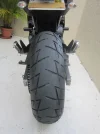I looked around and couldn't find any threads about tires specifically. I still have plenty of life left in the stock tires and I'm pretty happy with them to this point. But I really want to do a wider rear tire when I do need to replace tires. It looks like most of the "true sport bikes" i.e. R6, R1 etc... all come with either a 190/55/17 or a 180/55/17 tire. We have a 160/60/17 tire. So I have two questions.
1. I'm not completely clear on the way tires are sized and what exactly is being measured. 17 is obviously the wheel diameter. I know the 180 is the width and I believe the combination of 180/55 is some combination of the width and the side wall height. But where and what exactly are they measuring? And what units are they measuring in? Is it 180mm?
2. What's the widest tire you can run on our bike without some modification? I'd like to run the same size tire the R6 comes with. Not only does it look better to have slightly wider tire in the back but It seems like it must handle better. (I looked at the rear tire on a friends Ninja 250 that she just bought and laughed my ass off at how narrow it was. Looks narrower than my front. )
)
3. (OK I guess I have 3 questions) What brand and model tire has anyone switched to if any? I've read a number of articles about how our OEM tires are the best out there For An OEM Tire which tells me that most aftermarket tires are probably going to be considerably better.
I know in the mountain bike world, if you buy a complete bike from a bike shop, i.e. not build one up yourself from the components you choose, the tires generally leave a lot to be desired and there are a lot more options out there. I'm assuming it's a similar situation with motorcycles but I may be completely wrong.
1. I'm not completely clear on the way tires are sized and what exactly is being measured. 17 is obviously the wheel diameter. I know the 180 is the width and I believe the combination of 180/55 is some combination of the width and the side wall height. But where and what exactly are they measuring? And what units are they measuring in? Is it 180mm?
2. What's the widest tire you can run on our bike without some modification? I'd like to run the same size tire the R6 comes with. Not only does it look better to have slightly wider tire in the back but It seems like it must handle better. (I looked at the rear tire on a friends Ninja 250 that she just bought and laughed my ass off at how narrow it was. Looks narrower than my front.
3. (OK I guess I have 3 questions) What brand and model tire has anyone switched to if any? I've read a number of articles about how our OEM tires are the best out there For An OEM Tire which tells me that most aftermarket tires are probably going to be considerably better.
I know in the mountain bike world, if you buy a complete bike from a bike shop, i.e. not build one up yourself from the components you choose, the tires generally leave a lot to be desired and there are a lot more options out there. I'm assuming it's a similar situation with motorcycles but I may be completely wrong.
Last edited:


